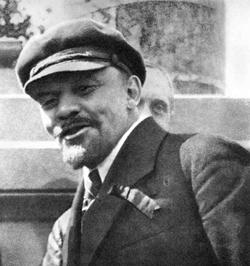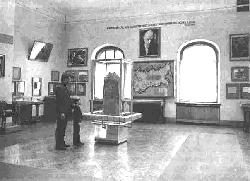Vladimir Lenin, the Architector of
the New Russian Socialist Society
|
| Large-scale Industry | 100 | 63 | 15 |
| Cast iron | 100 | 70 | 3 |
| Oil | 100 | 95 | 42 |
| Coal | 100 | 106 | 30 |
| Years | 1913 | 1917 | 1920 |
In comparison to 1913 the number of industrial workers in 1920 had decreased by almost half.
The condition of agriculture in the Soviet Republic in 1920 (in percentages compared to 1913):
| Gross output | 100 | 67 |
| Crop production | 100 | 64 |
| Live-stock production | 100 | 62 |
| Crop area In the Russian Federation | 100 | 75 |
| In the Ukraine | 100 | 80 |
| In Byelorussia | 100 | 70 |
| Years | 1913 | 1920 |
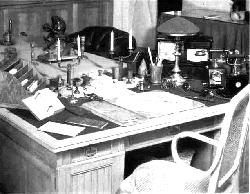
Lenin's famous plan of electrification of Russia (GOELRO Plan) was born in 1920, under conditions of utter ruin and starvation. This was a plan of the electrification of Russia, the significance of which Lenin defined in this way: "Communism is Soviet power plus the electrification of the whole country." These words express the basic contents of the entire exhibition in this hall. The GOELRO Plan was approved at the Eighth All-Russia Congress of Soviets, which took place in Moscow in the Bolshoi Theatre in December 1920. Lenin delivered a key report to the Congress.
The delegates to the Congress, conning from various places throughout the ruined country, poorly dressed, half-starved, sitting in the un-heated, scantly illuminated auditorium in the Bolshoi Theatre, listened with bated breath to the excitingly daring but realistic tasks and prospects of the socialist construction outlined by Lenin's genius. The Eighth Congress of Soviets unanimously approved the electrification plan. The resolution written by Lenin and accepted by the Congress expressed the confidence that the working people and peasants "will spare no effort and make all necessary sacrifices for the realisation of the GOELRO Plan in Russia at all costs and in spite of all obstacles". The report and other materials of the Congress occupy the central display in this exposition, including also a map of the electrification of Russia.
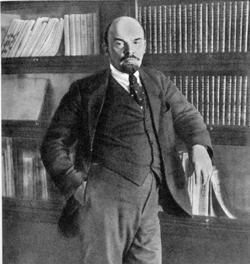
One of the photographs shows a group of Russian scientists, participants in the commission that developed the GOELRO Plan, in another, V. I. Lenin and N. K. Krupskaya with a group of peasants from the village of Kashino outside of Moscow taken on November 14, 1920, the opening day of the electric-power station built by the local agricultural co-operative. A model of the first hydroelectric power station on the Volkhov River as well as photographs of the first thermal electric-power stations are on display in this hall.
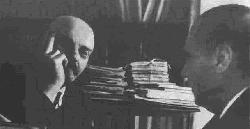
V. I. Lenin with the English writer H. G. Wells
There is an interesting photograph of V. I. Lenin with the English writer H. G. Wells, author of the book Russia in the Shadows, which he wrote after his trip to Russia in 1920. Lenin's electrification plan appeared a "Utopia of electrification" to the science fiction novelist.
"... Can one imagine a more courageous project in a vast flat land of forests and illiterate peasants, with no water power, with no technical skill available, and with trade and industry at the last gasp?. ..
"I cannot see anything of the sort happening in this dark crystal of Russia, but this little man at the Kremlin can. ..."
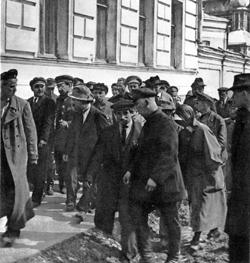
Lenin with a group of comrades. 1920
Numerous letters, telegrams and notes by V.I.Lenin, characterising his daily supervision in the organisation of the construction of power stations, the development of heavy industry, the restoration of agriculture and the cultural development, are shown in one of the display cases.
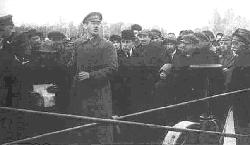

Lenin at the testing of the first electric plough. 1921.
V.I.Lenin invariably emphasised that large-scale industry, and first and foremost, industry based on electrification, was the material and technical basis of socialism and communism. In a speech at the Eighth Congress of Soviets, he said: "... if Russia is covered with a dense network of electric power stations and powerful technical installations, our communist economic development will become a model for a future socialist Europe and Asia."
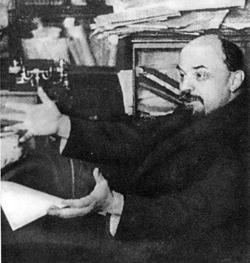
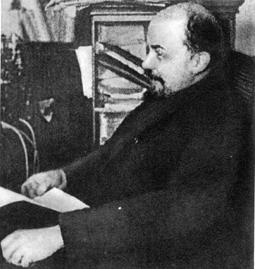
Lenin in conversation with Lincoln Eyre, an American journalist. (Stills) 1920.
Lenin's articles, remarks, pamphlets, letters, notes and instructions comprising the exhibition in the 15th hall portray the genius sagacity with which V. I. Lenin penetrated the crux of the problems that arose in the socialist construction within the country and in its international relations, how flexible and at the same time principled his decisions were on very different problems concerning the economic and ideological policy of the Party.
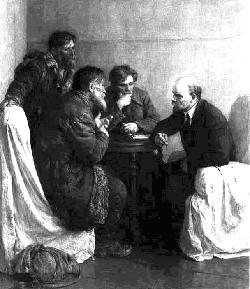
Acquaintance with the exhibit items in this hall and others shows the great and versatile work that Lenin carried on daily. Here, for example, is his schedule of February 2, 1921 found in this exposition:
Directed a meeting of the Political Bureau of the Central Committee of the Russian Communist Party (Bolsheviks).
Examined the draft of the Political Bureau's decision on the improvement of the peasant situation and made corrections.
Examined materials on the reorganisation of the People's Commissariat of Public Education and made remarks.
Wrote a draft on the status of the People's Commissariat for Public Education.
Wrote instructions of the Central Committee to Communists working in the People's Commissariat of Public Education.
Presided at the seventh meeting of the Economic Commission of the Council of People's Commissars, in which the fuel question was examined.
Examined and signed the directive of the Council of People's Commissars:
on granting financial aid to the Votsky Autonomous Region;
on combating desertion and the concealment of deserters.
Examined and signed the directives of the Council of Labourand Defence:
on the mobilisation of survey engineers, land surveyors and topographers and dispatching them to work in the appropriate enterprises and institutions;
on discharging from the Red Army survey engineers, surveyors, and topographers and dispatching them to the Main Surveying Department;
on the use of auto specialists, and the posting of them in the institutions in the auto department of the Supreme Economic Council;
on the work assignments of auto workers demobilised from the Red Army;
on sending workers and specialists in shipbuilding demobilised from the Red Army to work assignments under the People's Commissariat of Means of Communication;
on bonuses in kind to workers in the shipbuilding industry;
on supplying fuel for Petrograd;
on the control of loading and delivery of coal from the Donbas;
on the transportation of food supplies to the Donbas;
on the control of fuel expenditures;
on planned provisions for draymen enlisted in the loading and transport of firewood;
on the joining of the northern railroads system to the central system;
on the responsibility of directors in militarised institutions and enterprises in the selection and placement of personnel in production;
on legal proceedings against those responsible for red tape in the apparatus of the People's Commissariat of Communications.
Participated in the meeting of the Narrow Council of People's Commissars.
Examined and signed the minutes of the Narrow CPC.
Signed the directive of the Narrow Council of People's Commissars on the situation of war prisoners of the Polish Army.
Examined materials on the present state of land and food policies in Siberia and made notes on them.
Examined a coded telegram on the situation in Siberia.
Signed note on the situation with apartments in Moscow and sent it to the Narrow Council of People's Commissars.
Wrote a letter to the director of the Marx and Engels Institute with an inquiry about the completion of the collection of letters and published works of Marx and Engels.
Conferred with G. M. Krzhizhanovsky, the Chairman of the State Planning Commission.
Interview with V. N. Sokolov, a member of the Siberian Revolutionary Committee.
Signed the mandate of F. F. Syromolotov, a member of the Presidium of the Supreme Economic Council, on his work assignment to the Urals.
Wrote an answer to Syromolotov's note.
Wrote an answer to the secretary's note.
Spoke by telephone with directors of enterprises and institutions about various questions of socialist construction...
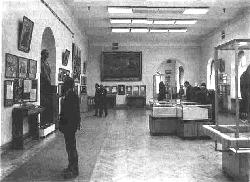
Documents on display demonstrate V.I.Lenin's irreconcilable struggle against all types of opponunists-anti-Party factional groups that did not believe in the victory of socialism, that spoke out against the directing role of the Party.
V. I. Lenin's report at the Tenth Congress of the Russian Communist Party (Bolsheviks) in March 1921 on the transition to the New Economic Policy (NEP) is located on the display stand. Directed toward the recovery from ruin, the strengthening of the unity of the working class with the peasantry, this policy was a necessary stage in the path to socialism. Here also is the Congress's approval of the NEP on the basis of V.I.Lenin's Report. Of special interest among the documents are the copy of the newspaper Pravda, in which V. I. Lenin's Report at the same Congress called "On Party Unity and the Anarcho-Sindicalist Deviation" appears, and Lenin's manuscripts of the draft resolutions of the Congress on this question.

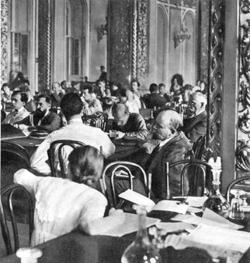
Lenin listens to the speakers at a session of the Third Congress of the Comintern. 1921.
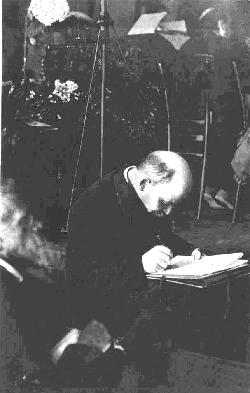
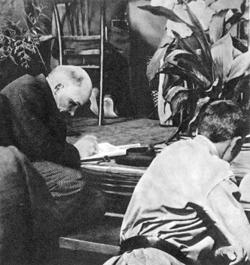
At the Third Congress of the Comintern. Sitting on the steps of the stage, Lenin prepares to make his address. 1921.
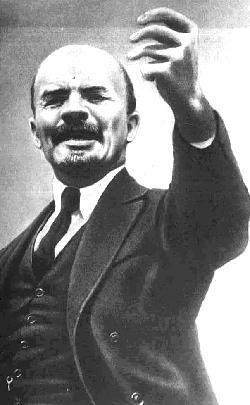
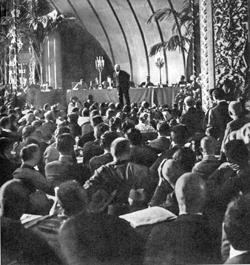
Lenin speaks before the delegates to the Third Congress of the Comintern. 1921.
Materials on Lenin's participation in the work of the Third Congress of the Communist International held in Moscow in the summer of 1921 are widely displayed in the hall; the manuscript of Lenin's Theses for a Report on the Tactics of the RCP, an issue of the newspaper Pravda with the text of the report, photographs of Lenin making a speech at the Congress and photographs of the delegates-representatives from various countries throughout the world. Among them were Marcel Cachin and Paul Vaillant-Couturier of France, Vasil Kolarov of Bulgaria, William Gallacher and Thomas Bell of England, Bela Kun of Hungary, Ernst Thalman and Klara Zetkin of Germany and others.

Lenin among the delegates to the Second All-Russia Congress of Miners. 1921.
Documents characterising the peaceable course in foreign policy of the Soviet state, and Lenin's policy of peaceful co-existence among states having different social systems, are an important part of this exposition. These are: "Draft Directives to the Deputy Chairman and All Members of the Genoa Delegation", "Draft Directives of the C.C. RCP(B) for the Soviet Delegation to the Genoa Conference". Here V. I. Lenin projects an extensive programme of struggle for peace and general reduction of armaments, economic co-operation and the establishment of trade and business relations of the Soviet Republic with capitalist countries.
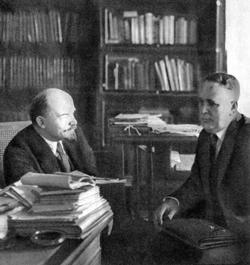
Lenin in conversation with P. Christensen, an American economist. 1921.
In autumn 1921 the Soviet Government, in an attempt to facilitate the establishment of economic co-operation with capitalist countries, offered to convene an international conference which would examine the claims of foreign countries against Russia and Soviet claims against them, and draw up conditions of peace between Russia and its opponents. Genoa was chosen as the location for the conference. The Genoa Conference took place in April-May 1922. However, it did not lead to any perceptible results.
Peace treaties concluded in those years between Soviet Russia and neighbouring foreign governments ”re exhibited here.
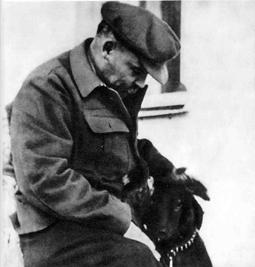
Lenin taking a rest from work in Gorki. 1922.
One section of the exposition is devoted to the Fourth Congress of the Communist International. This was the last Congress that V. I. Lenin attended. On November 13, 1922 he presented a Report at the Congress entitled, "Five Years of the Russian Revolution and the Prospects of the World Revolution", whose outlines, including those in German, are presented in the exposition. Here is a Chart: "Working People's International Aid to Soviet Russia":
France—almost 1 million francs;
Czechoslovakia—7.5 million korunas in cash and 2 million korunas worth of food;
Germany—1.3 million marks in cash and 1 million marks' worth of food;
the Netherlands-100 thousand guilders;
Italy-almost 1 million lire;
Norway-100 thousand Norwegian kronen;
Austria-3 million Austrian kronen.
